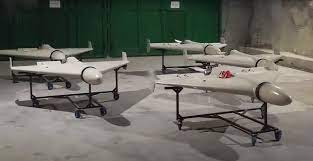The Iranian drones appear to be powerful and accurate. But the question is whether their deployment is too little, too late. JL
Andrew Kramer reports in the New York Times:
Shahed-136 attack drones (are) kamikaze drones carrying a warhead of 80 pounds. Its appearance in Ukraine is the first time it has been deployed outside the Middle East. The Shahed-136 is a delta-wing drone launched from the back of a flatbed truck. There was not any intelligence documenting the presence of the launcher or drones on the Russian side of the front. But remnants of a drone that crashed near the town of Kupyansk, apparently after malfunctioning, proved the weapon is in use
A new and, Ukrainian officers say, frighteningly effective weapon has appeared in the war on the Russian side: Iranian-made attack drones.
Russia and Iran never acknowledged striking a deal for the Shahed-136 attack drones, but a senior Ukrainian military official said remnants were discovered on the ground during the counteroffensive that Kyiv began in the northeast earlier this month.The powerful weapon is a so-called kamikaze drone carrying a warhead of about 80 pounds. Its appearance in Ukraine is the first time it has been deployed outside the Middle East.
The use of the Shahed-136 drones shows that while Russia remains mostly isolated internationally and was even rebuked just last week by leaders of China and India, Moscow has still found support from Iran. It also adds a layer of geopolitical complexity to the conflict as more nations are drawn into providing weaponry.In its first use in Ukraine, the Iranian drone blew up an American-supplied M777 howitzer used by the Ukrainian military, Colonel Rodion Kulagin, the commander of artillery operations in the Kharkiv counteroffensive, said in an interview. “It blew the triple-seven in half,” Colonel Kulagin said. “Instead of firing 100 artillery shells, it’s easier to release one of these drones” to seek a target, he added.
Half a dozen strikes destroyed howitzers and armored vehicles, killing four soldiers and wounding 16, he said. Russia’s use of Iranian drones was reported earlier by The Wall Street Journal. The appearance of the drones — even amid Ukraine’s otherwise successful and ongoing counteroffensive in the northeast — prompted Colonel Kulagin to appeal to Ukraine’s Western allies to quickly provide defenses or a similar weapon to strike back.
“Give us something like this,” Colonel Kulagin said. Drones have played a crucial role in the conflict already. The United States has supplied Ukraine with its Switchblade drones, and an attack on Russia’s Black Sea Fleet headquarters involved a drone. Ukraine has also deployed Turkish-made Bayraktar TB2 drones firing guided missiles.
The Shahed-136 is a delta-wing drone launched from the back of a flatbed truck. Colonel Kulagin said he was not aware of any intelligence documenting the presence of the launcher or drones on the Russian side of the front. But remnants of a drone that crashed near the town of Kupyansk, apparently after malfunctioning, proved the weapon is in use, he said.
The weapon drops out of the sky without warning, according to Colonel Kulagin and a Ukrainian artillery officer who witnessed one of the strikes. It is accurate enough to hit a self-propelled howitzer in a spot near the turret where gunpowder is stored, setting off secondary explosions, Colonel Kulagin said.
In such strikes nothing remains of the drone after detonation, he said. But witness accounts and the nature of the explosions, which were distinct from the damage caused by artillery fire, made the Ukrainian military confident in its assessment that the drones had been successfully deployed.
\
Debris from the crashed drone indicated that the Russian military had removed its Iranian markings. The drone was mislabeled on a winglet as a Geran-2 Russian-made drone, Colonel Kulagin said.
“It’s a very serious problem,” he said. Without countermeasures, he added, “they will destroy all our artillery.” It is unclear how many Iranian attack drones Russia has acquired. The U.S. national security adviser, Jake Sullivan, said in July that Russia intended to buy several hundred Iranian drones of various types.
There was no immediate response from Washington on the reports that the Shahed-136 drones were being used in Ukraine. On Friday, Gen. James Hecker, the top U.S. air commander in Europe, said that Russia was only “just getting” Iranian drones “so we really haven’t seen how they’re going to use them yet or how effective they’re going to be.
The Shahed-136 drones have so far only been deployed in northeastern Ukraine, Colonel Kulagin said. The first successful attack, on the M777 howitzer, was near the town of Chuguyev in August, before the counteroffensive began. The other strikes occurred in the past week or so, he said.
“They are testing them and have concentrated them in this region,” Colonel Kulagin said.
Captain Volodymyr Danchenko, an artillery officer whom the Ukrainian military made available for a telephone interview, said he witnessed a strike on a self-propelled howitzer — a tracked, armored vehicle that parks briefly to fire artillery before moving to avoid counterattacks.
The drone streaked in and obliterated the howitzer, he said.
“It was not like artillery that hit us before,” he said. “I haven’t met something like this before.”




















2 comments:
So don't put off learning the Wordle solution any longer - use our help today!
This is not very good news
Post a Comment